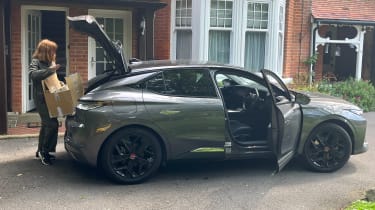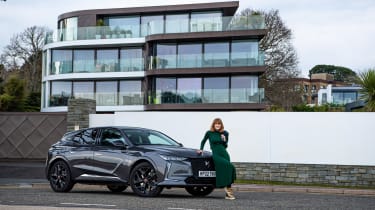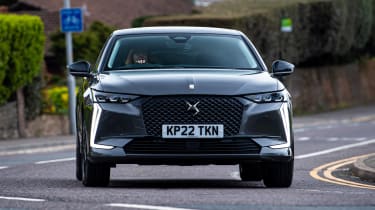DS 4 E-Tense 225: long-term test review
Final report: we’re going to miss our PHEV’s comfort and practicality

Verdict
We’ve been fans of the DS 4’s comfort from the start, but it has proved to be a practical hatchback, too. Some of the tech takes getting used to, but overall we’ll miss it.
- Mileage: 13,264
- Economy: 42.8mpg
After a brief four and a half months on our fleet, it’s time to say goodbye to the DS 4 PHEV. I’ll admit that when it first arrived, I was pretty confused, because it just didn’t seem to fit into any particular category. Its footprint is longer than many hatchbacks’, and it’s taller, but it doesn’t have the true height of an SUV. The classy styling and premium feel quickly won me over, though, and the car looks right at home in our main pic, looking across Poole Harbour to the affluent Sandbanks area of Dorset.
As I’ve reported previously, the DS 4’s interior comfort is first class, and by sticking to the company DNA of providing a relaxing and soothing ride, it has definitely worked, balancing well with the different exterior look. We’ve had no complaints on the few occasions passengers have used the rear seats, but with our children all grown up,
we haven’t really tested the DS 4’s abilities as a day-to-day family car.
Used - available now
However, when we needed to move some furniture, I wasn’t confident of fitting much in. The figures told me otherwise, and even when you factor in the 40-litre reduction in boot capacity that the PHEV suffers due to its extra tech, the boot is bigger than in premium hatchback rivals such as the Mercedes A-Class and Audi A3. But some of those styling cues that make the DS 4 look so good, such as the low roof and high boot lip, don’t give the impression that it will prove to be especially user-friendly when it comes to carrying bigger loads.
Still, my husband remained confident, and before I knew it, a chest of drawers was safely loaded, along with various bags. We’ve also removed an old brick fireplace during endless DIY work, so with the back seats folded and dust sheets in place to protect the interior, I actually found the boot the ideal height for loading up the heavy bricks and boxes of other debris for a trip to our local recycling centre, while the inset in the bootlid made closing it easy.
A novel feature inside the car is the second touchscreen located at low level on the centre console, I must admit to barely using this during our time with the car; I think as I spent more time as a passenger for the first couple of months, so there was just no need. But I gave it a go recently.
You can programme in six shortcuts and use it like a laptop trackpad, pressing your finger and dragging across to access the feature you wish to use without taking your eyes off the road. While it does work quite well and looks pretty cool, I think it’s one of those personal-preference extras, which you will grow to love or simply ignore.
Overall, though, the DS 4 has been a joy to run. With its premium looks, high level of comfort and ease of driving, it’s certainly been a favourite with my husband, who really didn’t want it to give it back.
DS 4 E-Tense 225: second report
Whether it’s doing yoga or driving our DS 4, picture editor Dawn is perfectly relaxed
- Mileage: 12,620
- Economy: 40.8mpg
I’ve been living with our DS4 E-Tense for a few months and my overriding feeling is that it’s a cocoon of comfort, which I’ve come to appreciate in a different light now that I’m doing more driving.
My husband usually takes the wheel on longer trips, so I’ve enjoyed the supportive sports seats from a passenger’s point of view. But after our move down to the south coast, I’ve been doing the 100-mile drive to London myself, and the peaceful and calming feel of the DS definitely makes the trip a more pleasant experience.
Our PHEV model is fitted with Active Scan Suspension as standard. This uses a road-scanning stereo camera to spot bumps, softening each damper in turn as the wheel hits. The downside is that the set-up only works in Comfort mode, but it definitely makes for a smoother ride.
The cabin is also really quiet for a car in this class, which is aided by the acoustic-insulated glazing that’s used for the side windows and windscreen. There are a few 50mph sections on my route with average-speed cameras, so the speed limiter comes in really handy. It’s made simple to use by the button mounted on the steering wheel.
I also like the light steering and soft suspension, but realise that, for some people, the lack of driver engagement might be an issue. On a trip to the New Forest at the weekend, my husband put the car in Sport mode for the twisty roads, which made the steering a little heavier and the drive a little more engaging. On the downside, we noticed a strange noise from the suspension that hasn’t occurred in any other mode.
Between us, we actually do use the four driving modes: Comfort, Sport, Hybrid and Electric. Hybrid is our default setting, especially when there is some electric charge available, but I’m all about the comfort for those longer journeys. Saying that, on my last trip back to the coast, I ran the car in electric for the initial town section after charging it up (92 per cent predicted a range of 19 miles) and forgot to switch back. It shows how quiet the DS is on the motorway, even when using the engine. I’d covered quite a few miles on the motorway before the charge ran out, so it did a good 28 miles on pure-electric drive, despite the prediction.
The rear seating in the DS certainly isn’t the roomiest in its class and although we haven’t carried passengers often, we gave some friends a lift recently. Both are less than six feet tall and they had enough head and legroom. They commented on the comfortable seating and were fans of the pull-down central armrest, providing each of them with a cup-holder for coffees. There is even an insert that can be removed so you can fit a larger water bottle in the space.
They also found the USB point handy for charging a phone while on the move, and the rear air vents provided extra comfort.
DS 4 E-Tense 225: first report
First report: we’re putting on the style with our new plug-in DS 4 premium hatch
- Mileage: 10,680
- Economy: 40.2mpg
I’ve swapped from one Stellantis product to another, but while there are plenty of similarities under the skin between our new DS 4 and the Vauxhall Astra that I previously ran, the French car looks and feels like a very different beast.
The DS 4 is aimed at premium hatchbacks such as the Mercedes A-Class, BMW 1 Series and Audi A3, and while the design has been toned down a bit since earlier DS models, it definitely isn’t trying to follow the crowd. Whether you appreciate the French idea of premium luxury or not, you have to agree that it stands apart from its German rivals.
Personally I like the exterior styling. The car looks chunky, with its slightly jacked-up appearance, while the rear light clusters that incorporate a diamond pattern are a real feature, along with the angled front daytime running lights. The large grille isn’t the prettiest and I’m undecided on the 19-inch Minneapolis alloys (maybe because they stand out so much that it adds to the fear of kerbing) but overall the car has a classy look.
Our particular model is the E-Tense 225 plug-in hybrid in Performance Line trim, and its four-cylinder petrol engine is backed up by an electric motor, while DS claims an all-electric range of around 37 miles. However, when it was delivered to me fully charged, the display was showing only 14 miles. Hopefully that will improve during our time with the car, although my lack of home charging will complicate matters.
It’s not cheap, either, with metallic paint (£595) and a two-tone roof (£300) taking the price to just over £40,000, but this version would be the choice for company car drivers with a low tax liability of 11 per cent. There’s plenty of kit, too, with keyless entry and start, front and rear parking sensors, electric folding and heated door mirrors, a 180-degree reversing camera, plus DS Active LED vision with Dynamic Bending Light function. There’s a raft of safety kit, too, while Active Scan Suspension reads the road ahead to reduce the impact if you hit a pothole.
The interior really does have a premium feel, with very little black plastic on display. The diamond styling cues are a little overdone for my liking, but I can imagine other people will appreciate the theme. Performance Line trim adds a sportier feel, with the stitching on the steering wheel, interior and seats adding a nice contrast to the black Alcantara used throughout.
The 10-inch infotainment screen is responsive and works wirelessly with Apple CarPlay, but while the instruments are slightly smaller at seven inches, the head-up display shows all the important info.
And as with the rest of the DS line-up, the DS 4 is very comfortable. The seats look and feel great, both myself and my tall husband are equally happy with them, and the interior is really spacious. Even the space in the back is good, something my daughter commented on when I gave her a lift.
The DS 4 also feels quite calming to drive, thanks in part to its smooth eight-speed automatic gearbox and the light steering, which is really appreciated around town.
| Model: | DS 4 E-Tense 225 PHEV Performance Line |
| On fleet since: | March 2023 |
| Price new: | £40,495 |
| Engine: | 1.6-litre 4cyl, petrol plug-in hybrid, 222bhp |
| CO2/tax: | 27g/km/£170 |
| Options: | Metallic paint (£595), Bi-tone roof (£300) |
| Insurance*: | Group: 30/Quote: £634 |
| Mileage: | 13,264 |
| Economy: | 42.8mpg |
| Any problems? | None so far |
*Insurance quote from AA (0800 107 0680) for a 42-year-old in Banbury, Oxon, with three points.















